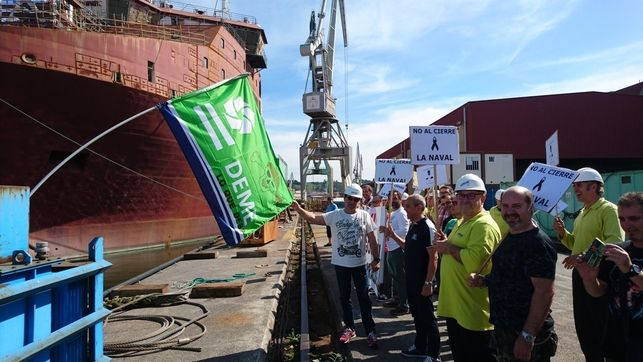Privatisation ends up scorching the shipyard
- On 30 August last, the Sestao Naval presented a competition for creditors that jeopardises its 220 jobs. The workers are not unemployed and on 21 September they will be holding a demonstration in the Left Margin. It is just the tip of the iceberg, as hundreds of people from subcontractors and small supplier companies working for the shipyard are much worse. Some say that the disaster began in 2006, when the Spanish Government left La Naval de Sestao (Bizkaia) in private hands.

“People can’t look.” This phrase, pronounced by a member of the management of La Naval at the meeting on September 11, caused resentment among the workers, more than one thought, “and where have you been looking so far?” Most of them attribute the current serious situation of the shipyard to the bad management of the company.
On the same day, the management announced the dismissal of 50 temporary workers and the opening of an employment regulation dossier for six months for the remaining members of the permanent working group. Those in charge of the company have claimed a lack of liquidity and a lack of workload in the labour market. The Naval has a portfolio of orders to build several boats, but at the moment the activity is very poor at the Sestao facility and the equipment is also paralyzed due to the debts and losses accumulated in recent years.
Competition for creditors or investor manga
The opening of the La Naval regulatory dossier, which has been in the competition of creditors since 30 August, can be considered as an advance on dismissal. However, avatars are not the present, as in 2014 he suffered a serious order crisis and the workers were sent home for a while until the workload was introduced. The construction of a ferry for the Dutch company TESO would have saved him, but that business and the following did not go as well as I thought. Thus, in the spring of this year he stopped paying suppliers and in early summer he presented the pre-competition. Naval accumulates losses of EUR 80 million, owes EUR 50 million to its suppliers and 150 million to the bank, which owes more money.
The increase in social capital could have been the way to deal with this money, a possibility that was very open a few months ago, waiting for the Asturian entrepreneur Manuel del Dago. From the 90-year-old dago, he lived in Miami, went from being a pastor in Picos de Europa to a potter in Colombia and the United States and now owns Naviera del Nervión, a company with 10% of La Naval's shares. A number of media have published that the entrepreneur is about to make a proposal, because if it were to enter into competition, the investor would not have the debt burden, but it would have to be seen how it would affect the workers.
This possible situation would not prevent the collateral damage between dozens of suppliers operating in the area, as La Naval would not compensate them for their debts. 40 or 50 small and medium-sized enterprises that concentrate most of their production in the shipyard, and together with the subcontractors employ about 1,600 people. If La Naval settles, it is they who will do the most damage, as they have much less strength to negotiate layoffs and pre-retirement. We can from Sestao have called for the implementation of a rescue plan for companies, including soft loans.
.jpg)
A little bit of history. Consequences of the 2006 privatisation
The responsibility for the management of the company lies with the shipyards Ingeteam and Murueta, which are the majority owners, with 38% of the shares. The workers know this and at the meeting held on 8 September between shareholders and the works council made it clear: Outside the Sestao plant there was a large banner with the guilt motto Ingeteam-Murueta. They claim that La Naval has been "uncontrolled" since it was bought in 2006.
The historical shipyard has suffered numerous ups and downs throughout its 108 years of history. Together with the well-known shipyard Euskalduna, it moved to the public sector in the 1970s and included several thousand workers. After the closure of Euskalduna in 1984, La Naval continued to operate and then moved to the Izar Group, also in the hands of the State, the public company managing industrial participations SEPI, until in 2004 the socialist government of Zapatero decided to keep the military part of the Izar Group and privatize the rest, including La Naval.
There were temptations to make warships in Sestao, but fortunately today it doesn't have that burden. However, as agreed by UGT and CAT with SEPI, the permanent workers of La Naval could still go to the Navantia society, which integrates the Spanish public military construction, with plants in Cartagena, Cádiz and El Ferrol, and have already submitted the request spontaneously in view of the dark panorama of Sestao.
In 2006, La Naval was transferred to the hands of Northern Naval Constructions, a company formed by several private companies. The Basque Government did not agree with the operation, which was strongly criticised by ELA. Before privatisation, 1,200 workers worked in Sestao and shortly thereafter reached 400. In the shipbuilding sector, however, the workforce is of great importance, and the Sestao factory has outsourced hundreds of people to carry out their demands, but in far worse conditions.
It is much more at stake than the jobs of the workers in La Naval: closure would highlight the deductive trend of the industry
Outsourced workers in 2009 protested because, taking advantage of the plight of foreign workers, they were driving “unfair competition” – according to ELA, they were carrying out precarious 60-hour weekly days. In any case, the unions made it clear that “all workers are victims of this behaviour”. Privatization has therefore left hundreds of people in helplessness in the face of precariousness and unemployment.
What about industrial policy?
The Basque Government has refused to put public money to save La Naval, considering that it is a "private initiative" company. The workers have reminded the self-government that they have already opposed privatisation and have asked it to take control of the shipyard because with this guarantee they will find means of financing. Specifically, for several economic analysts (see Juan Mari Arrangi’s column in number 2.565 of ARGIA) funding has failed; they have highlighted the attitude of Kutxabank and other similar institutions that are “blackmailing” the Basque Government to assume its debts with the banks.
The works council in La Naval has not been demoralised in seeking the involvement of the institutions and wants to set up a bureau with the Basque and Spanish Governments. Even when they have been with the leftist mayors – all of them from the PNV and PSE that make up the Urkullu Executive – they have asked for it, but in that respect they have not received any clear answer. On the other hand, they want the City Council of Sestao to “shield” the yard’s land to remain industrial; the ghost of urban speculation has been present in these geographically sweet lands since the beginning of privatisation.
In all this much more is at stake than the jobs of the workers in La Naval. The workshops and workshops on the whole left side would be affected by the closure of the shipyard, a tractor of the economy. But, in addition, it would be further proof of the cancelling trend that the industry has adopted in Hego Euskal Herria, and it would show that under the good macroeconomic data usually used by the Basque Government, a growth of 3% until 2018, there is another reality.
Langileek hiru hilabeteko erregulazio espedientea onartu dute, kable-ontzia amaitzeko “bermeak” edukitzearen ordainetan. Gaur aurkeztuko du konkurtsoa ontziolaren zuzendaritzak.
Armadorearen hainbat marinel gauez azaldu dira Sestaoko ontziolara eta amarrak askatzen saiatu dira azalpenik eman gabe. Langileek Ertzaintzari abisua jo ostean alde egin dute.























